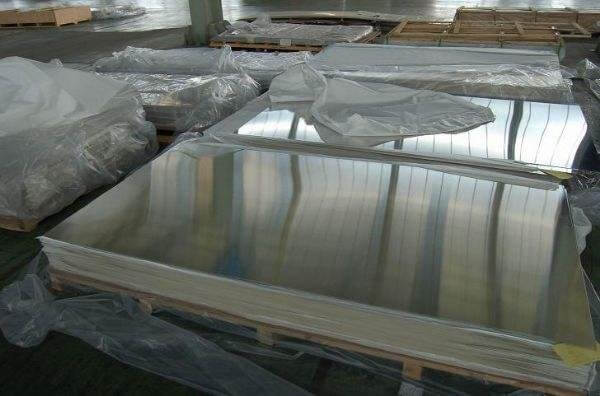- 0531-87887788
来源:http://www.jndclyyxgs.com/ 发布时间:2021-08-26
合金铝板的电解着色具有良好的装饰性,因此在国内外得到较广泛应用,特别是在建筑铝型材的表面处理生产中应用较为普遍。目前主要工艺是采用锡-镍混合盐电解着色,生产出的产品颜色以香槟色为主,相对于单镍盐着色,锡-镍混合盐电解着色的产品颜色光亮,色调饱满;存在的主要问题是产品存在色差,铝型材生产过程中的挤压工艺和氧化着色工艺的不合理都会导致产品出现色差。
Electrolytic coloring of aluminum alloy plate has good decoration, so it is widely used at home and abroad, especially in the surface treatment production of architectural aluminum profiles. At present, the main process is electrolytic coloring with tin nickel mixed salt. The color of the product is mainly champagne. Compared with single nickel salt coloring, the color of electrolytic coloring with tin nickel mixed salt is bright and full; The main problem is the color difference of the product. The unreasonable extrusion process and oxidation coloring process in the production of aluminum profile will lead to the color difference of the product.
挤压工艺对合金铝板的氧化着色的影响主要是模具设计、5052铝板挤压温度、挤压速度、冷却方式等对挤出型材表面状态和组织均匀性的影响。模具设计应能使进料充分的揉合,否则容易出现亮(暗)带缺陷,同一根型材上都可能出现分色;同时,模具状态及型材表面的挤压纹等也影响氧化着色。挤压温度、速度、冷却方式及冷却时间不同,使型材组织不均一,也会产生色差。

The influence of extrusion process on the oxidation coloring of alloy aluminum plate is mainly the influence of die design, 5052 aluminum plate extrusion temperature, extrusion speed and cooling mode on the surface state and microstructure uniformity of extruded profile. The mold design shall be able to make the feed fully knead, otherwise it is easy to have bright (dark) band defects, and color separation may occur on the same profile; At the same time, the die state and the extrusion lines on the profile surface also affect the oxidation coloring. Different extrusion temperature, speed, cooling mode and cooling time will lead to uneven structure and color difference.
阳极氧化对合金铝板电解着色的色差有很重要的影响,尤其是在立式氧化线生产过程中很容易出现两头色,立式氧化槽深7.5m,上下槽液容易产生温差,温度对阳极氧化有重要的影响,温度高,氧化槽液对氧化膜的溶解加剧,多孔型阳极氧化膜表面的孔径会加大,反之,多孔型阳极氧化膜表面的孔径较小。另外,温度高,阳极氧化膜的孔隙率较高,反之较低。
Anodizing has a very important impact on the color difference of electrolytic coloring of alloy aluminum plate, especially in the production process of vertical oxidation line, it is easy to have two colors. The vertical oxidation tank is 7.5m deep, and the temperature difference between upper and lower tank liquid is easy to occur. Temperature has an important impact on anodizing. High temperature intensifies the dissolution of oxidation film by oxidation tank liquid, and the pore diameter of porous anodic oxidation film surface will increase, On the contrary, the pore size of porous anodic oxide film is small. In addition, the porosity of anodic oxide film is higher at high temperature, and vice versa.
合金铝板电解着色主要是使着色液的金属离子在氧化膜的微孔内的阻挡层的表面上进行电化学还原反应,使得着色液中的金属离子沉积在阳极氧化膜孔的底部,对入射光发生散射而显现出不同的颜色,微孔中沉积的物质越多,则颜色越深。在通过相同的电量的条件下,温度高与低的部位上沉积等量的金属或金属化合物,对于孔隙率高和表面孔径大的部位,平均每个孔的沉积物要少,5052铝板所以其颜色相对较浅,反之颜色较深,从而造成了着色料两头色。合金铝板在阳极氧化过程中,导电性对氧化膜有影响,也会引起着色料产生色差,该问题主要是在卧式生产线容易出现主要是由于氧化坯料在氧化前的上排过程中,钳料不紧,导致个别料导电不好,从而使得其氧化膜相对有所不同,再经着色后,就会产生色差。
Electrolytic coloring of alloy aluminum plate is mainly to make the metal ions in the coloring solution carry out electrochemical reduction reaction on the surface of the barrier layer in the micropores of the oxide film, so that the metal ions in the coloring solution are deposited at the bottom of the anodic oxide film hole, scattering the incident light and showing different colors. The more substances deposited in the micropores, the darker the color. Under the condition of passing the same electric quantity, the same amount of metal or metal compound is deposited on the parts with high and low temperature. For the parts with high porosity and large surface pore diameter, the average sediment per hole is less. The color of 5052 aluminum plate is relatively light, on the contrary, the color is darker, resulting in two colors of coloring material. In the anodizing process of alloy aluminum plate, the conductivity has an impact on the oxide film and will also cause the color difference of coloring materials. This problem is mainly prone to occur in the horizontal production line. It is mainly due to the loose clamping during the upper row of oxidized blank before oxidation, resulting in poor conductivity of individual materials, which makes the oxide film relatively different. After coloring, the color difference will occur.